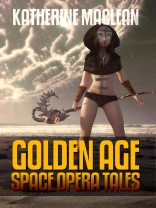Katherine Anne Mac Lean (January 22, 1925 – September 1, 2019) was an American science fiction author best known for her short fiction of the 1950s which examined the impact of technological advances on individuals and society.
Damon Knight wrote, 'As a science fiction writer she has few peers; her work is not only technically brilliant but has a rare human warmth and richness.’ Brian Aldiss noted that she could 'do the hard stuff magnificently, ’ while Theodore Sturgeon observed that she 'generally starts from a base of hard science, or rationalizes psi phenomena with beautifully finished logic.’
It was while she worked as a laboratory technician in 1947 that she began writing science fiction. Strongly influenced by Ludwig von Bertalanffy’s General Systems Theory, her fiction has often demonstrated foresight about scientific advances.
Space Opera is a subgenre of science fiction that emphasizes space warfare, melodramatic adventure, interplanetary battles, chivalric romance, and risk-taking. Set mainly or entirely in outer space, it usually involves conflict between opponents possessing advanced abilities, futuristic weapons, and other sophisticated technology.
The term has no relation to music, as in a traditional opera, but is instead a play on the terms 'soap opera’, a melodramatic television series, and 'horse opera’, which was coined during the 1930s to indicate a formulaic Western movie. Space operas emerged in the 1930s and continue to be produced in literature, film, comics, television, and video games.
The Golden Age of Pulp Magazine Fiction derives from pulp magazines (often referred to as 'the pulps’) as they were inexpensive fiction magazines that were published from 1896 to the late 1950s. The term pulp derives from the cheap wood pulp paper on which the magazines were printed. In contrast, magazines printed on higher-quality paper were called 'glossies’ or 'slicks’.
The pulps gave rise to the term pulp fiction. Pulps were the successors to the penny dreadfuls, dime novels, and short-fiction magazines of the 19th century. Although many writers wrote for pulps, the magazines were proving grounds for those authors like Robert Heinlein, Louis La Mour, 'Max Brand’, Ray Bradbury, Philip K. Dick, and many others. The best writers moved onto longer fiction required by paperback publishers. Many of these authors have never been out of print, even long after their passing.
Anthology containing:
- The Natives
- Games
- The Carnivore
- The Snowball Effect
- Pictures Don’t Lie
- Contagion
- The Man Who Staked the Stars
Scroll Up and Get Your Copy Now.












